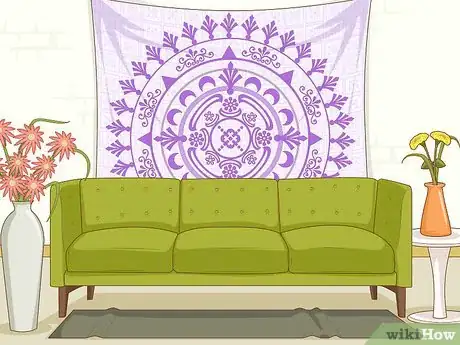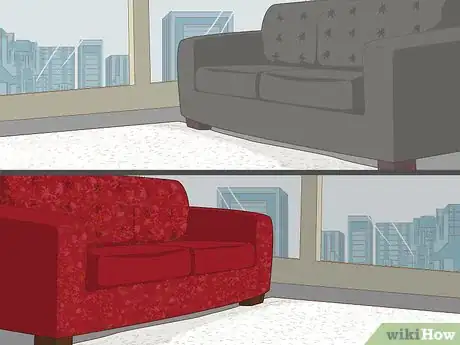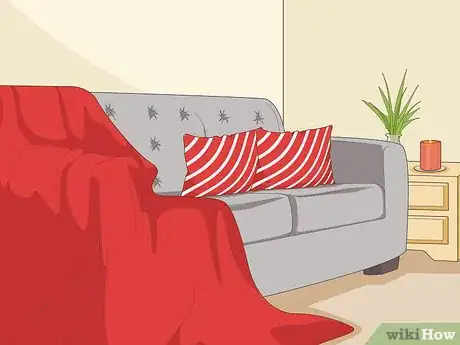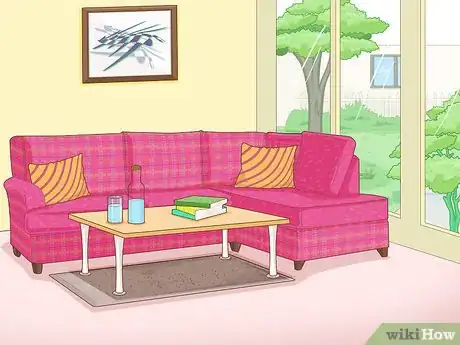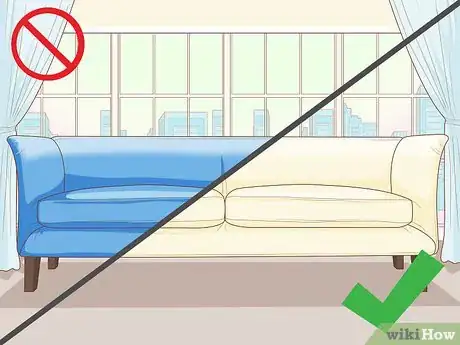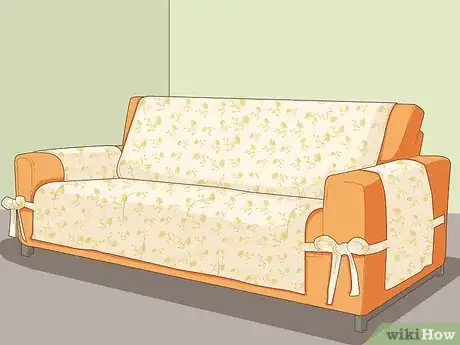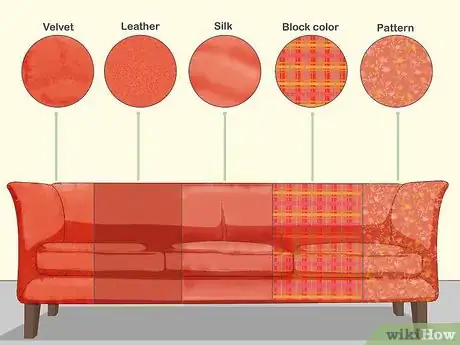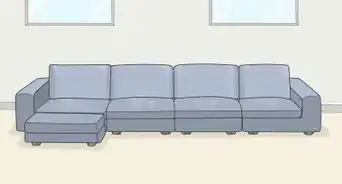This article was co-authored by Katherine Tlapa. Katherine Tlapa is an interior designer, currently working as a Design Specialist for Modsy, a design service based in San Francisco. She also runs her own DIY Home Design blog, My Eclectic Grace. She received her BFA in Interior Architecture from Ohio University in 2016.
This article has been viewed 63,721 times.
Besides being a spot for relaxation and gathering, a sofa tends to be the centerpiece of any room. Due to its size and placement, it's likely to stand out regardless of color or style. However, choosing the right color for your sofa can not only bring a room together, but make a proclamation about who you are. All you need to do is decide if you want to take the sensible, yet versatile route, or go all in with a bright, bold statement piece.
Steps
Choosing the Perfect Shade
-
1Search for inspiration before you shop. Pick up a few interior design magazines like Home Decor and Country Living to help get you started. These magazines will not only give you some helpful hints on choosing colors but will also be full of pictures of professionally designed rooms that can give you a clear idea of what you want. You can also search online on sites like HGTV or Pinterest for some insight and inspiration.
- You can also visit furniture stores and home decor shops to see what's in season and on trend.
-
2Use colors that complement your existing decor for a cohesive look. An easy way to choose a color for a sofa is to base it off other colors already in the room. Using complementary colors on the color wheel will guarantee a match and take out some of the guesswork in trying to find the perfect sofa shade.[1]
- For example, if you have a lot of orange in the room via lamps, rugs, or paintings, then a couch which has a blue hue would be a great addition. Or, if you have a large violet-colored tapestry, try a chartreuse or green sofa.
- You could also choose colors in the same family as your existing decor. if you have cool-colored wood floors, try a cool-colored couch. A black sofa would look great with gray flooring.
- If you're working with a new or empty room, you may want to pick a sofa in a neutral color so you can easily build off of it when decorating the rest of the space.
Advertisement -
3Make a statement with a sofa in a bold color or pattern. As a sofa is usually the centerpiece of a room, try making it stand out. Pick bold jewel-tones like jade, ruby, and sapphire or a contrasting color to make the sofa pop. For example, if you have bright white carpet, pick a dark gray sofa or something black. You can also pick large patterns like floral prints or chevron stripes to bring the sofa into the forefront.[2]
- Be mindful if choosing a particular pattern, though. Different fabrics can cause a sofa to cost more in the long run.
-
4Choose a neutral sofa to match any room. A sofa in a neutral color like cream, gray, or navy will look great in any room. You can also easily change the look of your sofa by adding throws or pillows.
- For instance, you could jazz up a gray sofa with a red blanket and a few pillows with a red and white pattern. When you get tired of the same look, swap out the red blanket for a teal and navy chevron one. Replace the pillows with solid-colored teal and navy pillows.
-
5Match the color to outdoor scenery to liven up the room. If you have a lot of windows, try pairing the sofa color with any outside greenery. For example, if you live in a heavily forested area, earthy tones like greens, browns, and tans would be complementary. Or if you have a large outdoor garden, you can match the sofa color to the shades of the flowers or plants.
- For those that live in a city, bring in some color from surrounding buildings. For example, look at the shades of surrounding brick or the dark gray of sleek metal structures nearby.
Looking at Outside Influences
-
1Take into account who will be using the sofa. Before you choose a color for your sofa, consider the other members of your family. If you have a roommate, children, or even a pet, you may want to go with a neutral dark or medium color like gray to hide potential stains.
- For example, small children are prone to making messes, and the last thing you want is to come home to a light colored couch covered in dirt and food residue.
- Similarly, pets like dogs and cats are likely to shed so you may want to match the color to their fur. This will spare you both constant worry and cleaning.
-
2Consider the location of the sofa. Think about where you'll be putting the sofa and how it may be affected by the location. For instance, if you plan to put the sofa in front of a large picture window, the sun could fade the fabric over time. Choose a color or pattern that won't fade noticeably, like gray or cream.
-
3Look at the overall motif of the room. Is the room you're placing the sofa in for relaxation, entertaining, or simply for show? If there is a set purpose or theme to the room, you will want the color of the couch to reflect this. If you plan to use the room for entertaining, for instance, you might want to choose a bold, bright color, like red or purple.[3]
- If you'll be putting the sofa in a room you use often, choose something that you won't get tired of easily, like a simple gray couch.
- If the room is a quiet place for relaxation, going for a light, minimalist color like a pale green or beige is a good choice.
-
4Think about your personality. If you're the type of person whose style is constantly changing, then you may want to go for a solid, neutral color. Though this may seem surprising, choosing a nondescript color and dressing it up with accessories like throw pillows is a great idea for someone with a shifting style. A gray, black, or navy couch works similarly to a blank canvas. It also works with pretty much any color you want to add to it.[4]
- You could also choose a sofa with several different slipcovers so you can swap out the cover when you want a change.
- For those with a more traditional, consistent style, you can choose any color you like. Though a solid is recommended over patterns for versatility.
-
5Choose a fabric based on your lifestyle. Depending on the members of your family or the kinds of friends you have, you may want to go for a specific type of fabric. For example, if you aren't worried about dirt or debris you can try for a linen couch. However, if you expect a lot of wear and tear, you may want to go with a more durable fabric like leather or wool. Keep in mind that each fabric is priced differently, though.[5]
- Leather can be both vacuumed and damp-wiped to clean, while wool resists wrinkling, fading, and pilling.
- Fabrics like velvet, chenille, tweed, and silk are not the best choices if you have children or pets. Opt for sturdier fabrics and patterns, which hide dirt.
- If you aren't sure what would look best in your room, try bringing a couple of fabric samples home. You can get free swatches from craft stores, or even whole fabric books online.
References
- ↑ http://www.homedit.com/choose-the-right-sofa-color-for-your-living-room/
- ↑ http://www.housebeautiful.com/home-remodeling/interior-designers/how-to/g1392/sofa-tips-0413/?slide=1
- ↑ http://www.homedit.com/choose-the-right-sofa-color-for-your-living-room/
- ↑ http://blog.westelm.com/2016/08/04/how-to-choose-a-sofa/
- ↑ http://www.bhg.com/decorating/lessons/basics/guide-to-upholstery-fabrics/
About This Article
You can make it easier to choose a sofa color by deciding if you want a color that complements the room or stands out. If you want a couch that's subtle and blends into your existing decor, choose a color that matches the other colors in your living room. If you have grey walls and floors, for example, try a grey couch. If you're looking for something that stands out and makes a statement, do the opposite. Choose a bright color, a couch with a vibrant print, or something that contrasts with the other colors in your space. If you’re unsure, go with a neutral color, like cream, gray, or navy blue, which pretty much go with anything. For more tips from our Interior-Design co-author, like how to choose a type of upholstery when you're couch shopping, read on!

